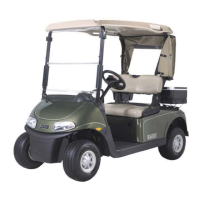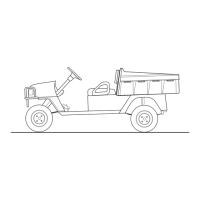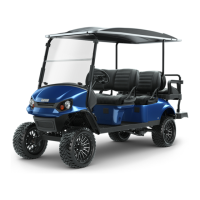OPERATION AND SERVICE INFORMATION
Page 18
Owner’s Manual and Service Guide
Read all of Manual to become thoroughly familiar with this vehicle. Pay particular attention to all Notes, Cautions and Warnings
Periodic Brake Test for Mechanical Brakes
The purpose of this test is to compare the braking perfor-
mance of the vehicle to the braking performance of new
or ‘known to be good’ vehicles or to an established
acceptable stopping distance. Actual stopping distances
will be influenced by weather conditions, terrain, road
surface condition, actual vehicle weight (accessories
installed) and vehicle speed. No specific braking distance
can be reliably specified. The test is conducted by latch-
ing the parking brake to eliminate different pedal pres-
sures and to include the affects of linkage mis-
adjustment.
Establish the acceptable stopping distance by testing a
new or ‘known to be good’ vehicle and recording the
stopping location or stopping distance. For fleets of vehi-
cles, several vehicles should be tested when new and
the range of stopping locations or distances recorded.
Over time, a subtle loss of performance may
take place; therefore, it is important to establish
the standard with a new vehicle.
Drive the vehicle at maximum speed on a flat, dry, clean,
paved surface (Ref. Fig. 26 on page 17). Quickly depress
the brake pedal to latch the parking brake at the line or
marker in the test area and remove foot from pedal. The
vehicle should stop aggressively. The wheel brakes may
or may not lock. Observe the vehicle stopping location or
measure the vehicle stopping distance from the point at
which the brakes were latched. The vehicle should stop
within the ‘normal’ range of stopping distances. If the
vehicle stops more than 4 ft. (1.2 m) beyond the accept-
able stopping distance or pulls to one side, the vehicle
has failed the test and should be tested again.
If the vehicle fails the second test, it should immediately
be removed from service. The vehicle must be inspected
by a qualified mechanic who should refer to the TROU-
BLESHOOTING section in the Technician’s Repair and
Service Manual.
AIR INTAKE AND COOLING FINS
To prevent possible
burns, engine parts
should be kept clean
to reduce risk of overheating and ignition of
accumulated debris.
After every off road use, allow to cool and then check for
a build up of dirt and debris in the air intake and cooling
fins. Dirt and debris may clog the engine’s air cooling
system. Clean areas shown to prevent engine damage
(Ref Fig. 27 on page 18) (Ref Fig. 28 on page 18). Keep
linkages, springs and controls clean. Keep area around
muffler free of any combustible material.
REAR AXLE
The rear axle is provided with a lubricant level check plug
located on the driver side at the rear of the housing (Ref
Fig. 29 on page 19). Unless leakage of rear axle lubricant
is evident, an annual lubricant check is sufficient.
Checking the Lubricant Level
Tool List Qty. Required
Socket, 13 mm, 3/8" drive............................................1
Ratchet, 3/8" drive .......................................................1
Funnel.......................................................................... 1
Clean the area around the check and fill plugs. Remove
the check plug. The correct lubricant level is just below
the bottom of the threaded hole (Ref Fig. 33 on page 21).
If lubricant is to be added, remove the fill plug and add
lubricant using a funnel. Add lubricant slowly until lubri-
cant starts to seep from the check plug hole. Install the
Fig. 27 Cleaning Air Intake
Fig. 28 Cleaning Cooling Fins
Ref Cai 1
ef Ccf 1

